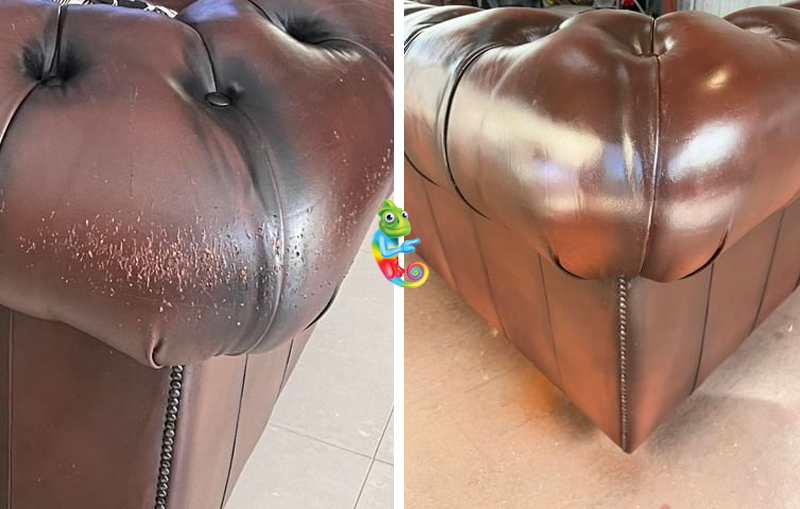
If you are a cat owner and own a leather couch, you may have experienced the frustration of finding scratches on your beautiful furniture. Cat scratches on leather sofas can be a major eyesore, and if left untreated, they can lead to further damage to the leather. It is important to address them promptly and properly to prevent further damage.
At Dyeing.com.au, we specialise in leather restoration at home and your business. In addition, we offer high-quality leather repair kits and leather dyeing kits that can be used to fix scratches on leather sofas.
What’s in this article:
1. Types of Leather Sofas
2. Understanding Cat Scratches on Leather Sofas
3. Fixing Cat Scratches on Leather Sofas
4. Common Myths About Fixing Cat Scratches on Leather Sofas
5. Preventing Cat Scratches on Leather Sofas
6. The Wrap Up
1. Types of Leather Sofas
There are many different types of leather sofas, each with its own unique characteristics and care requirements.
Full-grain leather sofas are made from the top layer of the hide and are the most durable and expensive type of leather.
Top-grain leather sofas are also made from the hide’s top layer but have been sanded or buffed to remove imperfections.
Split leather sofas are made from the bottom layer of the hide and are not as durable as full-grain or top-grain leather.
Suede leather sofas are made from the inner layer of the hide and have a soft, fuzzy texture.
Nubuck sofas are similar to suede sofas but have been sanded or buffed to create a velvety texture.
Faux or bonded leather sofas are made from synthetic materials and are less expensive than genuine leather.
Aniline leather sofas are dyed with a transparent dye that allows the natural grain and markings of the leather to show through.
Semi-aniline leather sofas are also dyed with a transparent dye but have a protective coating added.
Pigmented leather sofas are coated with a pigmented resin that gives them a uniform colour and a protective layer.
Each type of leather sofa requires different care and maintenance to keep it looking its best.
2. Understanding Cat Scratches on Leather Sofas
Cats love to scratch things, and unfortunately, leather couches are a popular target. Cats scratch for a variety of reasons, including stretching, marking their territory, and relieving stress. Leather couches are particularly vulnerable to scratches because of their texture and smell, which cats find appealing to scratch. When it comes to cat scratches on leather couches, there are different types of damage that can occur. Minor surface scratches can be relatively easy to fix with a simple leather repair kit, while deeper cuts and punctures can be more challenging to repair and may require our assistance.
Understanding the severity of the damage is crucial to determine the appropriate repair method. With our expertise in leather restoration, We can assess the damage and recommend the best solution to restore the couch to its original condition. Whether it’s a minor scratch or a deep cut, Dyeing.com.au’s leather repair kits and onsite repair services can provide a cost-effective and long-lasting solution to fix the problem.
3. Fixing Cat Scratches on Leather Sofas
When it comes to fixing cat scratches on leather sofas, the severity of the scratches and the type of leather play a crucial role in determining the appropriate repair method. Here are step-by-step instructions for fixing cat scratches on different types of leather sofas, including Chesterfield and Nubuck Sofas, using our high-quality leather repair kit and products:
Assess The Damage: Start by examining the scratches and determining their severity. Minor surface scratches can be fixed with a simple leather conditioner, while deeper cuts may require more intensive repair.
Clean the Leather: Before beginning any repairs, clean the leather thoroughly to remove any dirt or debris that may be present. Use a gentle leather cleaner and a soft cloth to clean the affected area.
Apply Leather Conditioner: For minor surface scratches, apply our high-quality leather conditioner to the affected area. Rub the conditioner into the leather with a soft cloth, making sure to cover the entire area of the scratch.
Apply Leather Filler: For deeper scratches or cuts, apply a leather filler to the affected area. Use a spatula or similar tool to spread the filler over the scratch, making sure to fill it completely. Allow the filler to dry completely before moving on to the next step.
Sand the Filler: Once the filler has dried, use fine-grit sandpaper to smooth the surface of the repair. Sand lightly in a circular motion until the surface is smooth and even.
Apply Leather Dye: If necessary, apply a leather dye to the repaired area to match the surrounding leather. Use a soft cloth or sponge to apply the dye evenly, and allow it to dry completely.
Apply Leather Conditioner: Finally, apply a leather conditioner to the repaired area to restore the leather’s natural moisture and suppleness.
It is important to use high-quality leather repair products and tools, such as those offered by Dyeing.com.au, to ensure the best possible results. For Nubuck Sofas, specific care should be taken as the material is sensitive to water and requires gentle handling.

4. Common Myths About Fixing Cat Scratches on Leather Sofas
Despite the abundance of information available on how to fix cat scratches on leather sofas, there are still many myths surrounding this topic. Here are some of the most common myths and the truth behind them:
Myth 1: Olive oil or Vaseline can fix scratches on leather sofas.
Truth: While it’s true that these products may temporarily improve the appearance of scratches, they can actually cause more damage in the long run. Both olive oil and Vaseline can penetrate the leather’s pores and cause it to become discoloured and brittle over time. Instead, it’s best to use high-quality leather repair products specifically designed for fixing scratches.
Myth 2: Scratches on leather sofas will naturally fade over time.
Truth: Unfortunately, this is not the case. Leather is a natural material that will not heal on its own. Leaving scratches untreated can actually cause them to become worse over time, leading to more costly repairs down the line.
Myth 3: Any type of leather repair product will work for all types of leather.
Truth: Different types of leather require different types of repair products. Using the wrong product can cause more harm than good. It’s essential to identify the type of leather before attempting any repairs and use products that are specifically designed for that type of leather.
Fixing cat scratches on leather sofas requires knowledge and expertise in leather restoration. Don’t fall for common myths that can cause more harm than good. Instead, use high-quality leather repair products and give dyeing.com.au a call if needed. With proper care and maintenance, your leather sofa can look as good as new for many years to come.
5. Preventing Cat Scratches on Leather Couches
Provide alternative scratching surfaces: One of the best ways to prevent your cat from scratching your leather couch is to provide them with alternative scratching surfaces. Cats love to scratch, so giving them a designated area where they can scratch to their heart’s content can help redirect their behaviour. You can provide your cat with a scratching post or mat made of sisal rope or cardboard, which are materials that cats love to scratch.
Use cat repellent sprays: Another way to prevent your cat from scratching your leather couch is to use cat repellent sprays. These sprays are specially designed to repel cats from certain areas, and they can be effective in keeping your cat away from your couch. Some sprays are made with natural ingredients like citrus or lavender, which cats don’t like, while others contain a bittering agent that makes the surface taste unpleasant. Please note some cat repellent sprays have a high ph and are not recommended on leather.
Trim your cat’s nails: Regularly trimming your cat’s nails can also help prevent scratches on your leather couch. When your cat’s nails are trimmed, they are less likely to get caught in the leather, which can lead to scratching. Make sure to use proper nail clippers made for cats and trim the tips of the nails. If you’re not comfortable doing it yourself, get your local vet to do it or take your cat to a professional groomer.
Use furniture covers: If you want to protect your leather couch from scratches, consider using furniture covers. These covers can be easily removed and washed, and they provide an extra layer of protection between your cat and your couch. You can also use throw blankets or slipcovers to protect your leather couch.
Train your cat: Finally, training your cat not to scratch your leather couch can be effective in preventing scratches. When you catch your cat scratching the couch, gently redirect them to their scratching post or mat. You can also use positive reinforcement by rewarding your cat with treats or praise when they use their designated scratching area. With time and patience, your cat will learn to scratch only in appropriate places.
The Wrap Up
Cat scratches on leather sofas can cause significant damage if not addressed promptly. Different types of leather require specific repair methods, and high-quality leather repair products and tools are crucial for successful restoration. As an expert in leather restoration, we offer a variety of solutions, including leather repair kits and onsite repair services. Don’t wait to restore your leather furniture to its former beauty. Contact us today for assistance.




